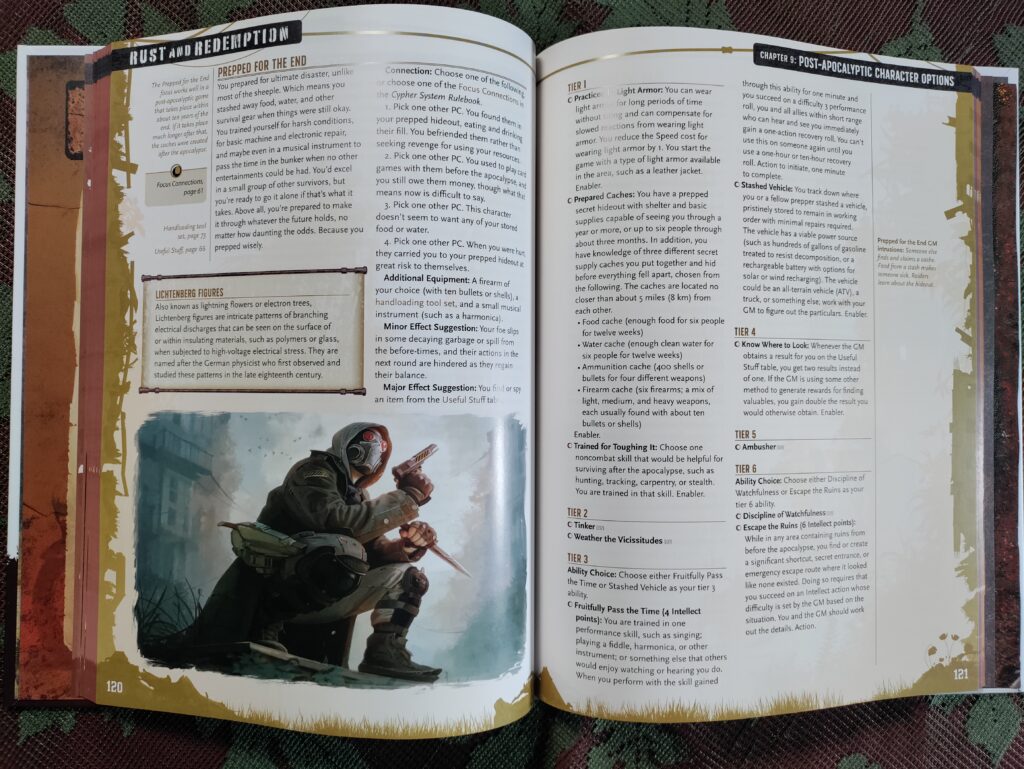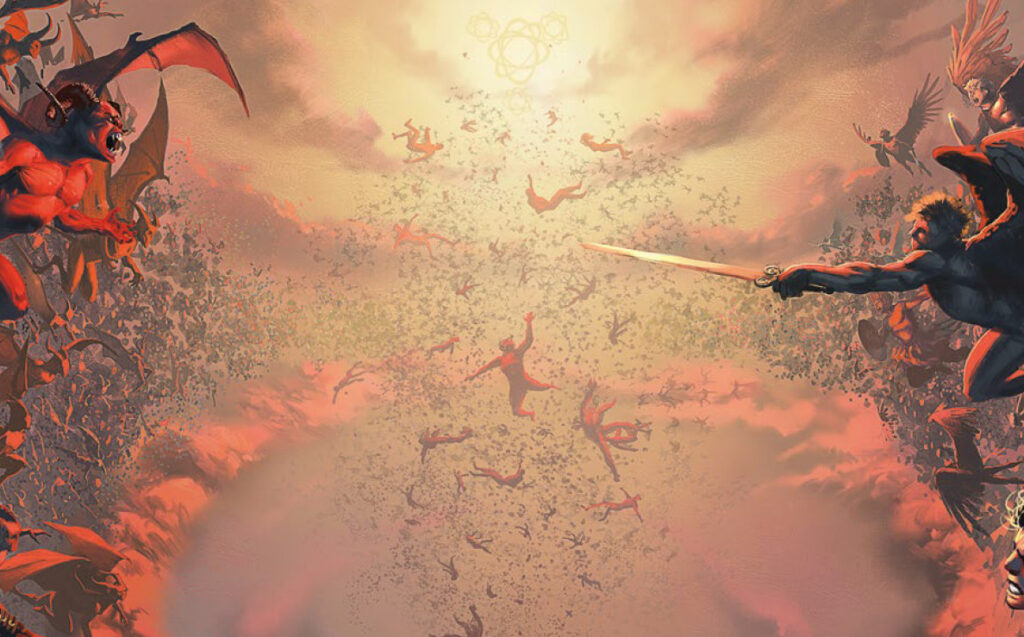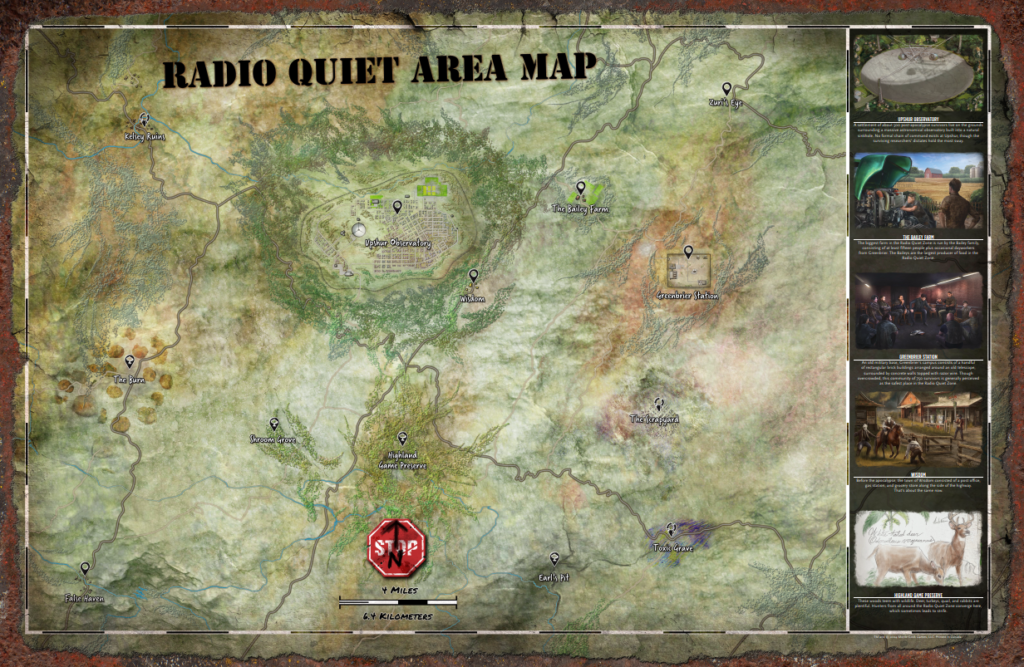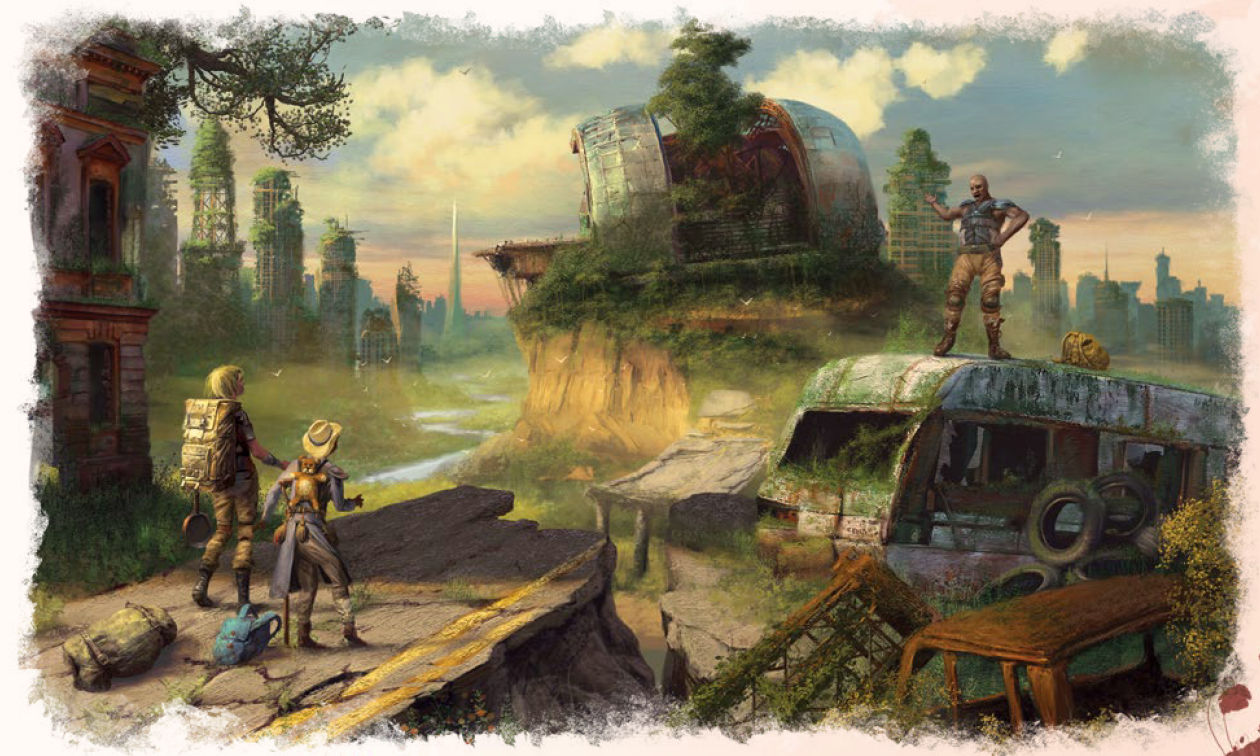RPG Elite contains links to affiliate websites and receives an affiliate commission for any purchases made on or through those websites. This helps to maintain and support the RPG Elite Network and mission. Thanks for your support.
A little over two months ago, Monte Cook Games released the Rust and Redemption post-apocalyptic expansion for the Cypher System tabletop RPG. In this article, I give a brief overview on what you can expect if you want to grab a copy of it.
The Packaging
The Cypher System Rust and Redemption expansion comes as a hardcover, 224-page book. It has a semi-glossy finish. The pages are a semi-glossy stock. As always, there are a plethora of talented artists (I counted about 30) who have contributed to the interior look which is something fans have come to expect from MCG.

The layout is three-column, with one being the info margin that points you all over the place and gives different notes where to find things in reference to what is being addressed on the page which is super convenient. This is especially so if you have the PDF version. Those notes are all hyperlinks which take you straight to the section. This is extremely convenient, keeping the customer in mind for their reading experience to be more enjoyable (hint for all aspiring tabletop roleplaying designers. Formatting matters).
There are four sections in Rust and Redemption — Worldbuilding, Player Characters, Settings, and Adventures.
Worldbuilding
Settings
This allows you to build your own post-apocalyptic world with the Cypher System from the ground up. It encourages you to draw on worlds from television, film, novels, and video games. Some of those mentioned in the book are Mad Max: Fury Road, Fallout (now on Amazon Prime), and The Terminator.
Or you can just draw from some of your favorite tabletop RPG settings like Gamma World or Mutant Year Zero. Ultimately, it will be a mix of several settings and once you are finished with the foundation, it will be something that is unique and yours alone.
Themes
In the section on themes, one thing it mentions that’s key in a post-apocalyptic setting is the despair vs. hope ratio. However, I saw some subtle ideology beginning to creep in, which I am not down with. This is what it says on page 12:
For many, despair turns to anger. In a hopeless situation, people want to feel some control. Anger gives them a sense of purpose, even if that anger is directed—as it often is—at marginalized groups.
Understand — I like the Cypher System. But you can keep that stuff because it’s for the birds. That paragraph isn’t necessary and you can delete it and the flow is not affected one bit getting across the same idea. It’s actually extraneous.
On the next page they mention “consent” which is just another creative roadblock (aka safety tool) couched in a different term. I will not get into that in this post. I will dedicate an entire post (and video) to why it’s the same thing and just as bad while trying not to be. I don’t have to ask permission from anyone to play a game. Never will. However, like I said, another topic for another time.
Yes. I know the ideological, far-leftist leanings of Monte Cook Games. I’ve know it for years. However, my concerns are primarily on two fronts.
The first is whether they are pushing that agenda hardcore and, in effect, hating their customer base openly as a company. The second is whether money goes to things that do not align with my values. That’s when I’m dipping out from supporting them or their products. Y’all know what’s up.
Other points they suggest to weigh against are brutality vs. humanity, a very real theme that shows up in post-apocalyptic stories, and rust and redemption, explaining what the rust part of that phrase means.
It moves on to balancing realism and the fantastic, or the natural vs. the supernatural, commonality vs. rarity. This is highlighted with a section on the shelf life of things.

From there you figure out how the world ended (fun endeavor for sure), and they have a table for that you can use as a prompt to get some ideas. I dig that.
Set Pieces and Plots
Next are creating set pieces and plot devices. It lists tables to choose or roll on that include groups, locations, and secrets. It also gives suggestions on certain set pieces in the realistic vs fantastic range, anywhere from pandemics to the End Times.
Coming from my Christian worldview, I’m impressed they even included that last one. The vehemence against Christianity, especially from the left which is where tabletop RPG companies lean, press and promote any and everything that deviates from anything even remotely relating to Christianity unless it is in a negative sense. It’s all over in the entertainment industry. This has been going on for three decades.

To be sure, the End Times is mad scary and a time of great turmoil. It is, as the term says, the End Times. Everything as we know will end. However, what comes after is not people trying to survive. It is a fulfilled story of ultimate hope, truth, and victory.
However, you could add your own twist on that in myriad ways to tell a wide array of stories. So, even though they are who they are ideologically, I see this as a sign they haven’t completely lost all objectivity, so kudos to them for including that in Rust and Redemption.
Some of the different plots they include can be chosen or rolled on the Plot Seed Table. This should get the creative juices flowing for a multi-session adventure.
Optional Rules
Rust and Redemption has optional rules you can pick and choose from covering things like scavenging, repairing, and building (one I would definitely include from jump), to incredible mutations ala Gamma World. There are a bank of tables for things like Useful Stuff and Junk that you can populate your setting with.
Ending Material
The last two chapters in this section covers Threats, Hazards, and GM Intrusions you can throw at the PCs as they try to survive the last chapter of new Creatures, and NPCs.
Player Character Options
The next sections adds some additional details for those who want to make characters specific to the setting. There are eight new descriptors, four being standard, and four being entirely new species.
It then has an entire section dedicated to currency and equipment, and ends with a section on new cyphers and artifacts for your post-apocalyptic setting.
Pre-Made Settings

If you do not have the time to make your own post-apocalyptic setting from the ground up, you can use the one they have included, the Radio Quiet Zone. There are key landmarks of that setting, like the Greenbriar Station, and the Upshur Observatory. They also have a section letting you know what’s outside the Radio Quiet Zone, covering specific points of interest like the
Adventures
The final section of Rust and Redemption gives you five pre-made adventures ready to go. The first three are longer scenarios called The Quick Fix, Bitter Seeds, and Safe Zone. The last two are called Cypher Shorts which are more like adventure jump off points, listing the premise, specific character types, a setup, suggested encounters, a few GM Intrusions, and short conclusion. Takes up no more than two pages.
In the very back of the book is a folded up map with landmarks and key locations in the Radio Quiet Zone.
Where to Buy Rust and Redemption
There are multiple places you can get Rust and Redemption. The two most prominent would be the MCG Store and Amazon.
Looks like someone is going have some fun worldbuilding tonight.

